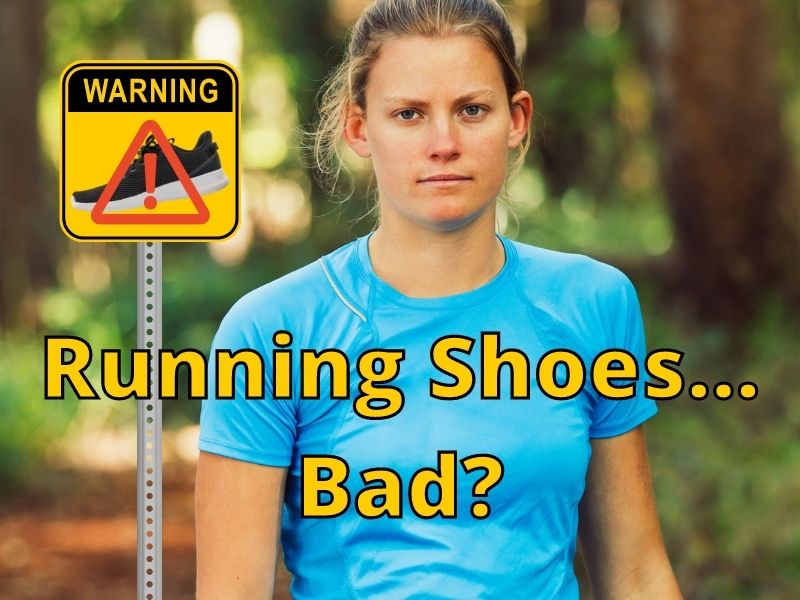I wear shoes almost every day. I recommend them for running and for protecting your feet in situations that are not safe for bare feet. Yet, shoes can have some negative side effects.
Running shoes are great at helping protect your feet and joints from the repetitive impacts that occur during running. They also control foot mechanics and toe placement, which can cause foot problems over time.
Running shoes aren’t inherently bad but they can prevent feet from exercising in a natural manner which can prevent healthy muscle development and proper bone alignment.
Biomechanical Foot Movement
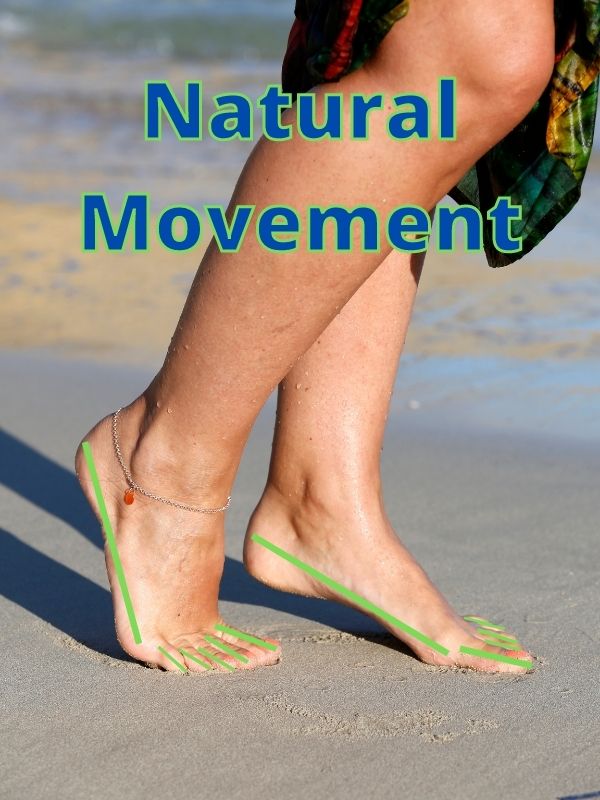
If tomorrow we were all forces to go shoeless, what would happen? Our feet and legs would start to walk in a natural position. That would mean our muscles and bones would start to adapt to this new way of moving. Our foot mechanics work very differently in a shoe versus without one.
Without shoes, our feet would get stronger over time because the toes and other muscles in our feet would be engaged much more. This may also start to align the bones in our feet differently than before.
In time our bones would be more naturally aligned and our feet would be stronger. Eventually, we could start running and our feet and legs could support the weight of our body, so with each foot strike, our feet would be able to absorb the impact without injury occurring.
Negative Running Shoe Factors – Instability
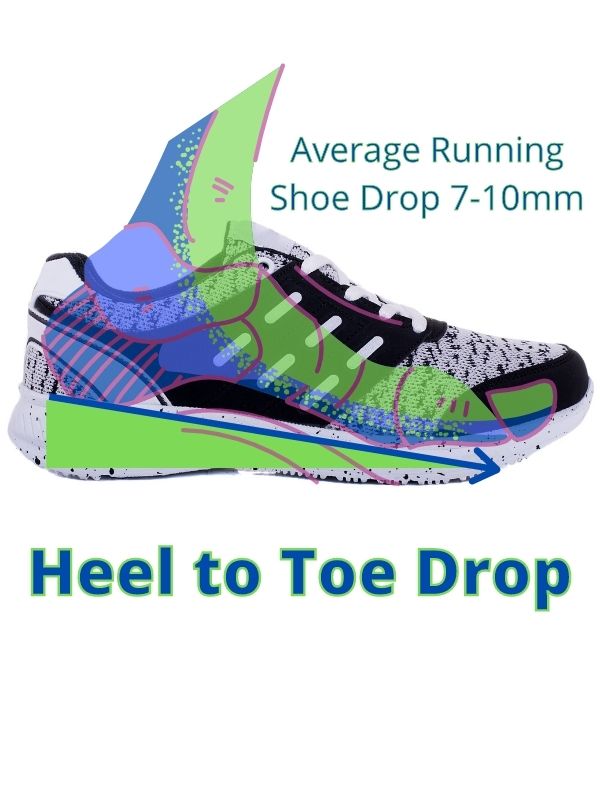
Without shoes, our feet contact the ground with the heel and toes on a fairly even plane. Muscle engagement is different when wearing shoes versus not wearing them.
Running shoes are usually great at helping you run without getting an injury. They provide protection for your feet and cushioning so your joints receive less of an impact. Yet, they aren’t perfect and can cause foot and leg problems.
One of the problems that running shoes may cause is instability. They can create “instability issues” and forces “the knees and hips to take more stress at impact” (podiatrytoday.com). Most running shoes have a “7-10mm” heel to toe drop. (thewiredrunner.com)
This unlevel plane is supposed to help runners fall forward, making running easier. Although, an unlevel plane can create more joint stress and may encourage over striding which leads to heel strikes.
While not all modern running shoes will cause instability. The higher the heel-to-toe drop, the greater chance you may have of causing instability and possibly stress on your joints. There are other factors to consider as well.
Positive Running Shoe Factors – Cushioning?

Many running shoes have a good amount of cushioning. When I look at some of the more expensive running shoes, many of them have thick cushioning that is made from more expensive materials.
This is good for runners who run for long periods because the foam can absorb impacts for a long time without compressing as much. The midsoles of more expensive shoes tend to be a mix of EVA (ethylene vinyl-acetate) and TPU (thermoplastic polyester-urethane).
They also use other materials at times but usually don’t talk about their formula specifically and give special names to their insole technology.
Shoes with “cushiony and wide midsoles” tend to help “shock absorbency and reduced force on metatarsophalangeal joints” (podiatrytoday.com)
Those who tend to heel strike find that extra cushioning can help relieve pain caused by striking with their heel. Sometimes this comes in the form of a large heel-to-toe drop, but other times thick cushioning is added to a low drop or zero drop shoe.
Still, the foot can’t articulate naturally with a thick layer of foam. This can lead to weaker muscles even though the feet are more protected.
What About Zero Drop Running Shoes?
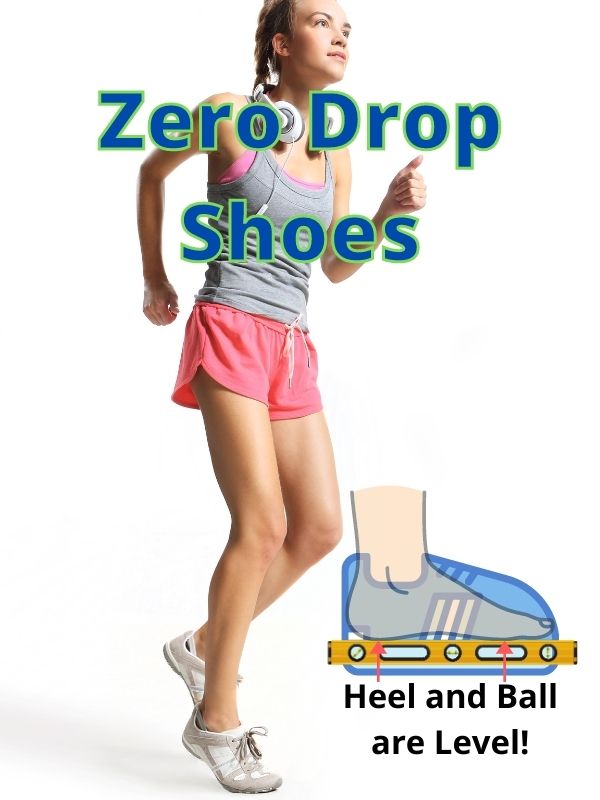
Zero drop shoes mean that there is no difference in height between the heel and the toes, they are level. This increases stability for runners, so they are less likely to get injured as a result of the angle of the foot.
On a level plane, the feet can function more naturally, which could lead to better alignment of bones and a more natural running position.
If you read my article about Zero Drop Shoes, it says that studies suggest that zero drop shoes are “helpful for your feet and joints, but if your feet are not healthy, it could result in knee pain.”
So, those who wear zero drop shoes should make sure they have stronger feet without any injuries, so they can benefit from wearing them.
Many zero drop shoes have minimal cushioning, but some have a lot. Which is best for your feet?
That depends. If you have strong foot muscles that have adapted over time to little cushioning, then a minimalist shoe with little cushioning could be helpful for natural foot movement. Then you could benefit from the strength of your foot muscles, your arch, and your toes,
You would have more control over your foot and be able to articulate your toes for more stability. Many runners claim that minimalist shoes are the best.
If you look at the chart below, it can take a while to transition over to zero drop shoes and it should be taken slowly, especially with shoes that have little cushioning.
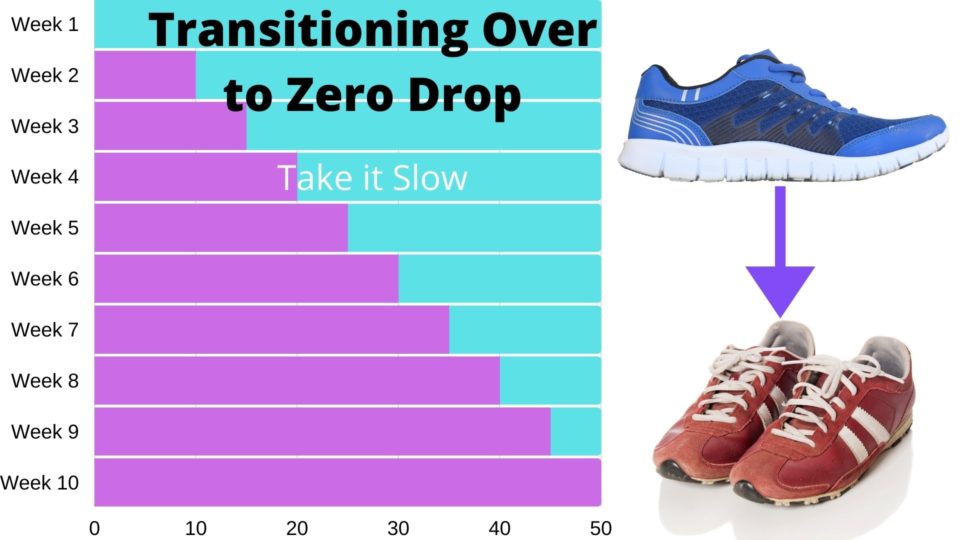
If you have always worn shoes and haven’t developed your foot muscles, then cushioned zero-drop shoes would be most helpful.
If you get zero drop shoes with lots of cushioning, you may not need as much time to adapt to these shoes, because the cushioning is doing a lot of the work that your feet would need to do with a little cushion.
Your feet will be in a more natural position but will not be able to develop the muscle strength and stability that comes with a minimalist shoe or little cushioning.
What About Minimalist Zero-Drop Running Shoes
If we walk without shoes on, our feet can have a natural range of motion. Our toes can each have muscle engagement. So, depending on the running shoe you get, your feet will have more opportunities to develop muscles and a healthy range of motion.
Many people who run in minimalist shoes claim that these are better for your feet. They say they are better because your feet move in more natural ways. According to James Speck, minimalist running shoes have helped him to land on his feet differently, helping get rid of his knee pain. (fixflatfeet.com)
When we run, we don’t want to strike our heel on the ground, which some running shoes may encourage our feet to do. Most running shoes usually have a higher level of cushioning in the back than the front, encouraging forward motion, but with unnatural biomechanics.
Minimalist shoes encourage natural biomechanics, so feet can grow stronger and have a healthy range of motion.
Yet, one problem with these shoes is that most runners’ feet aren’t ready for these shoes. It takes time for your feet to adapt and grow stronger.
How Did You Grow Up?

If you grew up like me, always wearing shoes your entire life, then your feet haven’t been able to develop the natural biomechanical muscle strength and stability that comes with walking without shoes.
In some countries, many of the people grew up only wearing sandals and flip-flops. Their feet were able to adapt to these types of shoes and they don’t have lots of foot problems.
Why? As I understand it, growing up without shoes helps develop your foot muscles much better than with them.
So even if you had flat feet, if you grew up without wearing shoes, you would likely not have foot problems because of all the muscles that absorb the impact of your foot strike. Their natural bone alignment helps them take on any stresses that may occur from weight and impact.
So, while I might have an arch, my muscles aren’t as strong or adapted as those who never wore shoes. If you made me wear sandals or flip-flops every day I might start to have problems after a while because my feet aren’t adapted to these shoes.
If you gave someone who never wore shoes some running shoes to wear all the time, their feet would likely need to adapt to the shoes. Runners also need to adapt to new shoes if they are very different from the shoes they have worn before. Otherwise, they are likely to get an injury.
Wearing shoes for the first time in their life would start to weaken their foot muscles over time as the shoe did most of the work that the muscle had done before.
If the shoe had good arch support, then their arches wouldn’t need to do their job as much and it would also get weaker.
Depending on the type of running shoe they wore, their bones would need to adapt to a new angled plane and new stresses on the bones. The natural biomechanical movement of the foot would need to be adjusted.
Healthy Running Shoe Use
Exercise can help our feet get stronger. There are many exercises we can do to help with foot development. Physical therapists often ask you to exercise to correct various problems.
Athletes who train hard often need to go to a physical therapist to help them recover from injury and help them with exercises that will strengthen their muscles and align their bones.
A lot of the problems that athletes encounter can be avoided if they just follow some of the training advice they may not have been aware of.
We can also avoid the problems that running shoes can cause if we exercise our feet, train ourselves to run correctly, and get the right running shoes.
I think the overall goal for runners should be to improve their foot strength over time and choose a shoe that provides the right amount of cushioning for their needs.
They should be aware of their running style and if that is causing some of the issues that they may be encountering. They should also pay close attention to their shoes and if the shoes are causing problems.
Final Thoughts
Running shoes can be good for our feet, but foot strength needs to be taken into account. We need to make sure our shoes are not causing more problems than they are solving and that our running stride is healthy.
I personally think that a cushioned zero drop running shoes are a great option for runners looking to transition to a more natural biomechanical shoe. Just make sure to switch slowly between your regular running shoes and your new zero drop shoes over time, so your feet can adapt.
Thanks for visit Helpshoe.com
References
https://thewiredrunner.com/heel-to-toe-drop-what-is-it-and-what-to-look-for-in-running-shoes/

